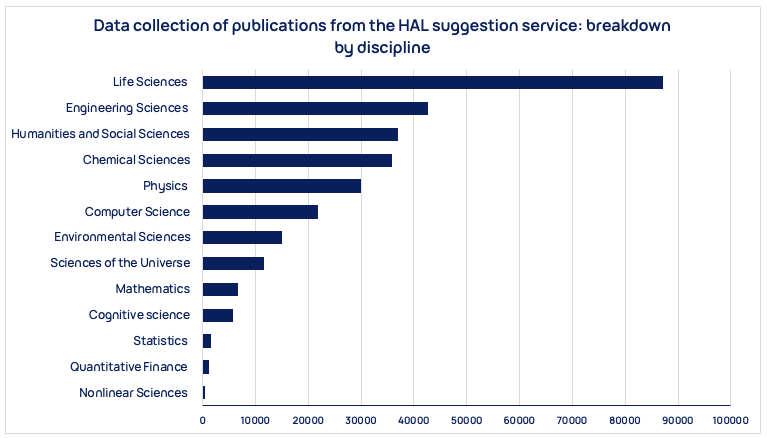The HAL deposit suggestion service is stepping up a gear! Authors now have direct access to the bibliographic references for their publications, which have been collected in advance. They just need to attach the file containing the full text and specify the licence to finalise the deposit.
Would you like to deposit the full text of your publication? HAL may already hold the information needed to complete the submission form, such as bibliographic references, author affiliations and discipline. How can you find out? It’s very simple: after logging in, go to the Deposit Suggestions menu in your user space and click Import your file.
The proposed list is extracted from an Inist database, which collects French scholarly publications and performs various documentary processing tasks. Only documents with a DOI can be processed.
Until now, HAL has only used this database to identify publications for which a full-text file is available under a Creative Commons licence and can be automatically retrieved, offering authors the option of importing it into the archive. If the publication is already present in HAL, only the file is imported. If the publication is not referenced at all, a new deposit is created. These publications are listed under the Automatic Import tab.
Since the launch of the deposit suggestion service in December 2023, nearly 19,000 files have been imported.
Optimising the suggestion service: a way to simplify deposits
Why not go even further? With this database, HAL has the metadata describing 270,000 publications. Why not open up this reservoir to authors to make depositing easier? For each of the publications listed in their personal space, all that remains is to upload the full text file and associate a license.
The suggestions, of course, take into account what already exists in HAL. They provide an overview of HAL records without the full text file.
For each suggestion, you simply need to upload your file. You will then be prompted to choose a license.
To illustrate the richness of the database, lets have a look to some statistics.
The publication years range from 2014 to 2025. If you would like to add all your publications to your HAL CV and you still have the relevant files, don’t hesitate!

With almost 90,000 documents, the life sciences are undoubtedly the most well-represented discipline in this corpus.

As a reminder, the discipline you selected in your submission preferences can be used to refine the suggestion service criteria, which is useful if you have namesakes who publish in other scientific fields. You can take it a step further by activating the ‘Co-authors’ parameter. This criterion is based on the co-authors listed in publications already present in HAL, helping to identify your own publications more accurately in the suggestion database and thus narrowing down the list of suggestions.
The CCSD has several objectives b optimising the use of the suggestion service:
- Firstly, to facilitate deposits: authors simply need to upload and link the file containing the full text to the metadata of the publications automatically suggested in their space. This significantly reduces the amount of manual data entry required and encourages full submission.
- The service relies on automatic collection to simplify submission, and the results are made available to users, providing them with reliable and structured metadata.
The suggestion service is also designed to avoid duplicates by offering only publications whose full text is not yet in HAL. This guarantees data quality and prevents redundancies. - Barriers related to the absence of licence information are removed: for publications that are already open access, the absence of a licence specifying the conditions for reuse is no longer an obstacle to their appearance in the user space. This increases the visibility of the work while ensuring compliance with legal frameworks.
These improvements strengthen scientific sovereignty by contributing to the enrichment of HAL and securing open access to the results of public research. These improvements are being implemented as part of the Equipex+ HALiance project.